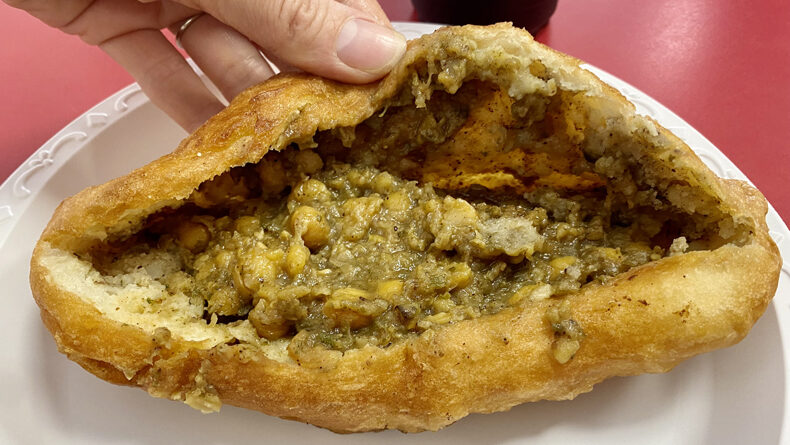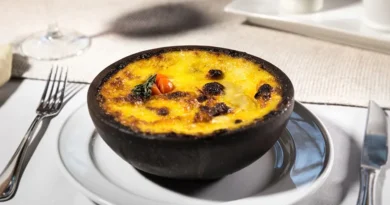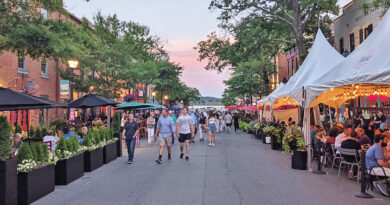South Richmond Hill: A Self-Guided Food Tour for the Senses
South Richmond Hill, where Little Punjab meets Little Guyana in southeast Queens, is one of the most fascinating, diverse—and, at times, overwhelming—neighborhoods of New York City. But getting to know this cultural and culinary treasure trove is rewarding and easy if you know where to go, whether it’s an afternoon food adventure you’re after or just a great spot to eat near JFK airport. Here’s how to eat your way through South Richmond Hill using this step-by-step self-guided food tour (and public transit).
This post is sponsored by the Queens Economic Development Corporation.
In Southeast Queens, South Richmond Hill is a little rectangle of a neighborhood, where neat rows of Colonial-style homes intersect with avenues that casually transport you across the world. It’s a sudden transition that might surprise you if you’re not prepared for it, but the cultural shift you’ll experience via the eateries, markets, places of worship, and shops is so pronounced around here it can take your breath away.
Coming from the north, you first hit 101st Avenue, 12 blocks of which were officially dubbed Punjab Avenue in 2020 to reflect the huge Sikh community here (111th-123rd Sts.). Imposing gold-topped gurdwaras, or Sikh temples, peek out from between houses on quiet tree-lined streets; restaurants advertise chole bhature and Punjabi thalis. Markets are stocked with fresh pani puri, paratha, and spicy crunchy snacks you won’t want to live without.
Two avenues south, you are on thrumming Liberty Avenue, in the heart of Little Guyana. The Indo-Caribbean presence here is palpable every step you take, in the plethora of produce and grocery markets, Guyanese bakeries and Trinidadian roti shops, Guyanese-Chinese restaurants, saree (sari) shops, and mandirs, or Hindu temples. Inside the markets, the rows of imported West Indian hot sauces, achars, and juices invite exploration to anyone unfamiliar with them, while the restaurants beckon with innumerable fun snacks in glass cases and tempting steam tables that seem impossible to eat your way through. Everything on Liberty Avenue lights up the senses. Where to begin?
This self-guided food tour is designed to bring a visitor through Richmond Hill using public transit and introduce, mostly via food, some of what makes it such a special place. The sensory explosion and deep cultural immersion here can feel overwhelming to a newbie—this guide hopes to make it more approachable so visitors can confidently navigate the streets, menus, and markets with ease, and learn a little bit along the way.
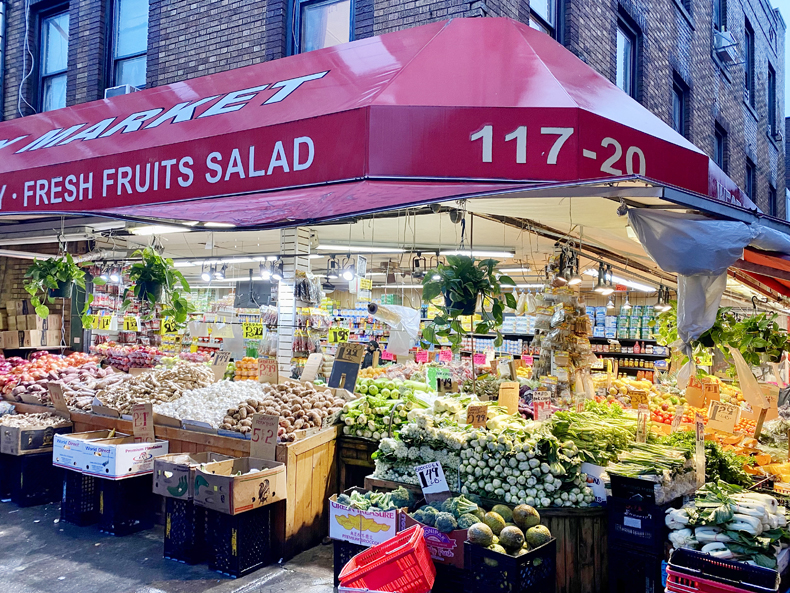
How to Use This Guide
This walking food tour is a loop that begins and ends on Lefferts Boulevard at 101st Avenue, where public transit is readily available. Allow yourself a few hours to complete it, and note that if you are eating alone or with a small group, you will likely not be able to eat everything in this guide! Pick and choose the top 5-6 stops you’re interested in and skip a few.
(Note that if you just want to know where to eat quickly near JFK airport, you’ll want to skip to stops 4 or 5 for aloo pie or doubles. Both are great to grab and go with, or even save for later as a plane meal.)
No matter what, you should bring a sturdy bag and perhaps some containers for leftovers and purchases, and we suggest having your own reusable utensils, a refillable water bottle, hand sanitizer, and a mask for indoor use. If you are planning to visit the Sikh temple, bring a head covering (a scarf or handkerchief, not a baseball cap—they’ll provide something if you forget) and wear shoes you can easily remove.

You will note that some of the more famous South Richmond Hill restaurants—Sybil’s Bakery & Restaurant, Veggie Castle II, Singh’s Roti Shop—are not on this food tour. This is both by design and not: All three are located farther east along Liberty Avenue, too far to fit into a loop route from our starting point, but also, these places are already well known and make for great destination-eating on another trip. You definitely should visit them too!
Finally: As noted above, this post is sponsored by the QEDC, but beyond that it’s been a small labor of love for me, as I’ve spent hours on repeat visits to Richmond Hill getting better acquainted with the neighborhood, chatting with people there, and diving into its history. It reminds me a lot of Jackson Heights, where I’ve lived for 14 years, and anyone who’s taken my guided food tours there knows well the passion I have for that neighborhood! With this project, I’ve fallen for Richmond Hill too, and I hope you do as well.
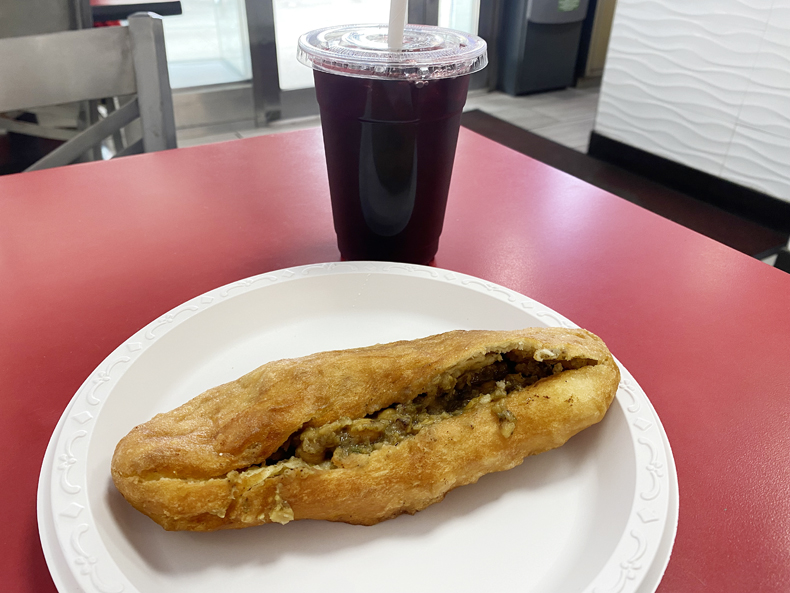
A Quick History + Geography Lesson
To travel around Richmond Hill is to dip into West Indian culture, which comes with a deeply complex and painful history. At the minimum, it’s important to know that as Dutch and British colonies, both Guyana and Trinidad used many African slaves on their sugarcane plantations and rice fields. When slavery was abolished in the 1830s, the Africans were replaced by indentured servants from India, who lived and worked under exploitative, unjust, slave-like conditions. Chinese and Portuguese workers (the latter mostly from the Madeira Islands) were likewise exported for labor. Hence, there are prominent influences in Indo-Caribbean food from India, China, and Africa, as well as from the Native Americans who preceded them. (The British influence is mostly seen in the love for cricket, and also perhaps the egg ball—see stop 6 of this tour. The Dutch also had a presence in Guyana, as the first colonizers, but not to the extent as in neighboring Suriname.)
Trinidad and Tobago gained independence from the British in 1962, Guyana in 1966.
Trinidad and Guyana share a similar Caribbean cuisine and culture, and are both geologically on the South America continental shelf. However while Trinidad is a dual-island nation (alongside Tobago) in the southern Caribbean, Guyana is located on mainland South America, on the North Atlantic coast (it’s the only English-speaking country on the mainland).
So how did Richmond Hill come to have the largest concentration of Guyanese outside of the homeland? In the 1960s, to escape a dictatorship and seek out better work conditions, many Guyanese left home for the U.S., Canada, U.K., and other places. New York City saw a big influx in the late 1960s and 1970s, when the Guyanese were settling in low-rent areas of Manhattan and Jamaica, Queens. Not yet in Richmond Hill—in fact, during the late 1970s, there was still intense resistance (from the longtime Irish and Italians in this area) to non-whites in Richmond Hill. In the 1980s, once the aging Caucasian population started leaving the area, the Indo-Caribbeans (and Indians) could move in. And they sure did—within a few years the neighborhood was transformed, with once-rundown Liberty Avenue turning into a booming Indo-Caribbean business district. (Source here.)
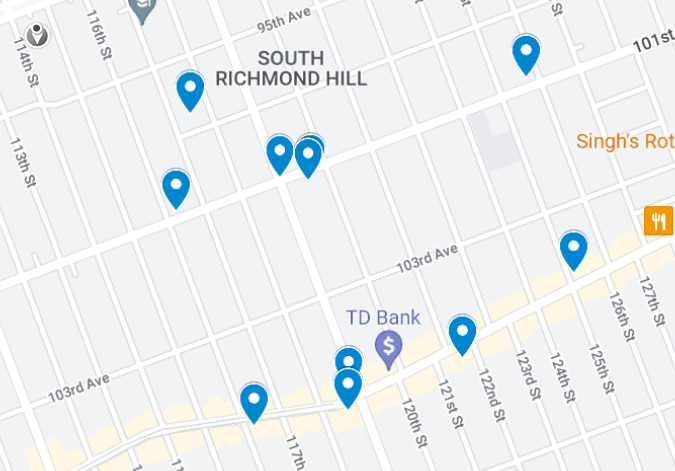
Getting to Richmond Hill
For the purposes of the loop route in this guide, we will start on 101st Ave. and Lefferts Blvd. To get there via public transit, take the E or the F train to the Kew Gardens-Union Turnpike stop (one stop past Forest Hills-71 Ave.) and transfer to the Q10 bus. In the subway station, exit following the Q10 signs; once you’re on the street, be sure you’re on the Kew Gardens Rd. side, not the Queens Blvd side, to catch the bus (you should be in front of Green Olive Grocery). You can take any of the Q10 trains that show up, regular or limited-service. That bus ride is usually 15 minutes or less.
You can also take the J train to 121st St. and walk two blocks west on Jamaica Ave. to Lefferts Blvd. to catch the Q10 bus heading south. It’s less than 10 minutes on the bus to reach 101st Ave.
If you opt to ride the A train to the end of the line, you’ll be on Lefferts Blvd. at Liberty Ave., in a good place to start at stop 3 of this tour. Be sure you’re on the Ozone Park/Lefferts Blvd.-bound A, not the Rockaway-bound A.
All the stops of this food tour are mapped here.
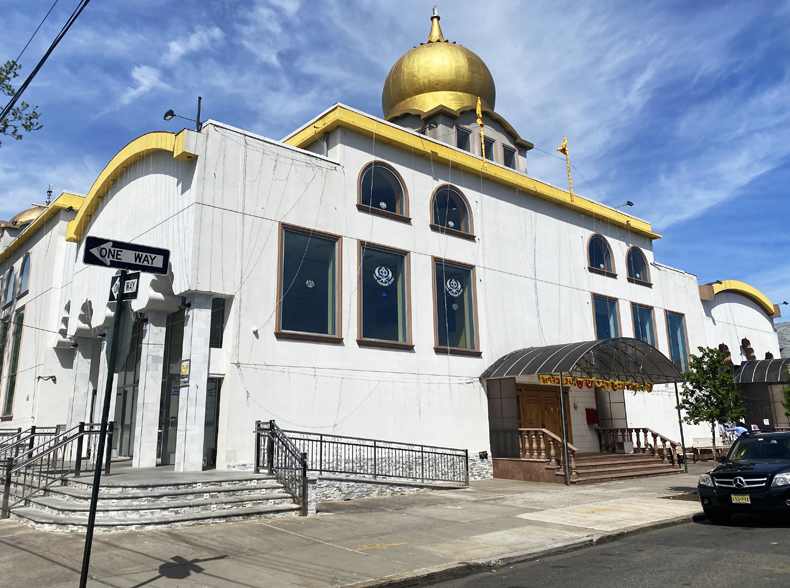
Stop 1: Chai at Gurudwara The Sikh Cultural Society Inc.
This tour starts in the heart of Little Punjab, and there’s no better way to immerse yourself in this culture than to visit one of the local Sikh temples (gurdwara = “door of the guru”). You can’t miss the gold dome atop Gurudwara The Sikh Cultural Society Inc. (95-30 118th St.). To reach it, backtrack to 97th Ave. (aka Gurdwara Ave.) and turn left. It’s located one block west of Lefferts on 118th Street.
At the temple’s entrance you’ll find cubbyholes for leaving your shoes. It’s customary to remove your socks as well (there are slip-on shoes left in the bathrooms in case you need those there). Be sure you have a scarf or handkerchief, and not a baseball cap, to cover your head with. Once you’re ready, follow the carpet past the bathrooms—you’re supposed to wash your hands at the sink outside—and into the diwan hall, or main prayer hall, where you’ll probably hear chanting. Sit and listen for a while; all are welcome here. When you’re ready, leave the room and look for the stairs taking you down to langar hall.

The langar, or free kitchen, is key in Sikhism, reflecting a belief in the oneness of humanity. In this volunteer-run community eating and gathering space, free (vegetarian) meals are offered to anyone and everyone, 24 hours a day. Grab a metal cup and fill it up with sweet, milky chai from the big black urn—there’s a lot to eat today as it is, but you’re welcome to return one day and dig into the roti, dal, and whatever else is being served. You can sit on the floor, or at a table in the back of the room. Soak in the quiet, calm atmosphere, and when you’re done, bring your cup to the dishwashing area in the back corner of the room. Be sure to thank a volunteer if you see one!

Bonus stop: En route to the next stop you might want to pop into Singh Farm (117-05 101st Ave.), an Indian grocery store with produce, bagged paratha, fresh pani puri, great spicy snacky things (the green chutney-style Kurkure chips are highly recommended!), and, in a nod to the community just south of here, West Indian ingredients like sorrel and senna pods.
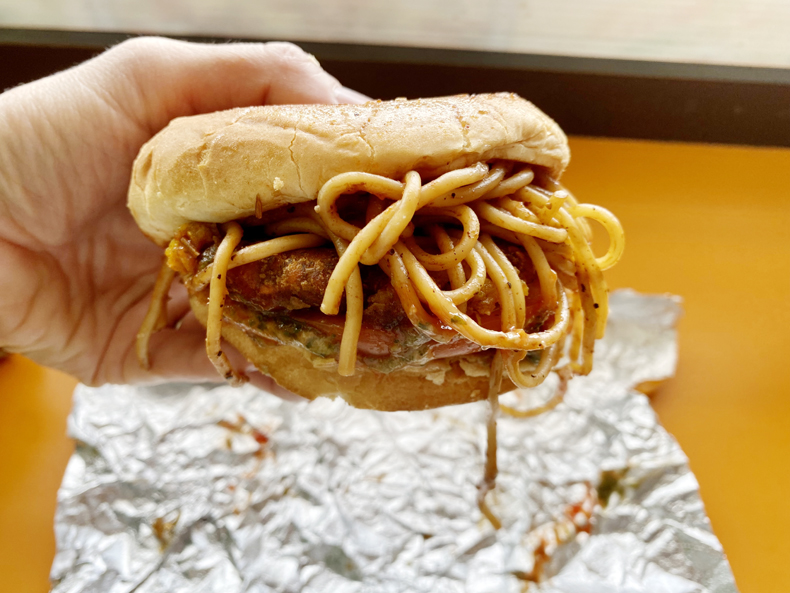
Stop 2: Punjabi burger at Desi Bites
Post-temple, make your way to Desi Bites (116-03 101st Ave.), between 116th and 117th Streets. This small eatery deals in Punjabi fast food, which means lots of chaats, thali platters, and tiffin services, but it’s really known for its Punjabi burgers. That’s what you’re here for.
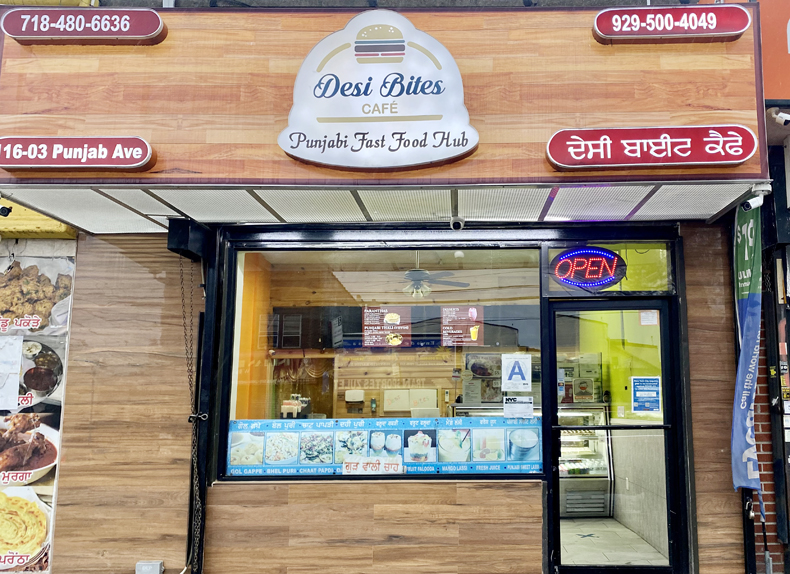
The Punjabi burger is a vegetarian aloo tikki (potato) patty that comes loaded with noodles, lettuce, tomato, red onion, and various chutneys including green chutney and ketchup. It’s pretty messy, but delicious and unique (also, I’ve been told, a popular dish in Punjab state), and therefore a must-try in this area. I suggest half a burger per person so as not to fill up too much—ask the counterperson to cut the burger in half for you.
While the shop deals mostly in takeout, there is a little counter along the window if you’d rather eat on-site.
Order: Punjabi burger, cut in half ($5.50); order with a slice of paneer for an extra dollar. Accepts credit cards.

Stop 3: Guyanese pastries at Little Guyana Bake Shop
Cross the street and take 116th St. two avenues south to Liberty Avenue. You’ll pass lots of neat little houses and land squarely in Little Guyana. This part of Liberty runs underneath the A train, and the vibe feels immediately different: loud, bustling, colorful.
Little Guyana Bake Shop (116-04 Liberty Ave.), with two locations in South Richmond Hill, provides a great introduction to Guyanese baked goods. It’s also a grocery store with fish, meat, and dizzying displays of cooking sauces, pepper sauces, and chutneys. Depending on the time of day, the back bakery counter will be filled with many typical sweet and savory pastries. I suggest starting with some of each: a soft pine tart, filled with pineapple jam; a flaky cheese roll, which has seasoned sharp cheddar inside; and black-eye cake (aka Chinese cake), which is reminiscent of a Chinese bean-filled bun but uses black-eyed peas, a native African legume. There’s Guyanese cuisine for you: a Chinese preparation meets African ingredients to create a Caribbean dish.

As for the cheese roll, its savoriness, and the slight taste of mustard in the cheese mix, reminds me of Welsh rarebit, a popular English dish. You might also want to grab a salara (a red-colored coconut bread roll) for later, and perhaps a drink from the fridge.
All of these snacks are staple Guyanese bakery items, and there are many more. Bring them outside to taste. You could take a bite of each and save the rest for later—no judgment here!
Order: One pine tart, one cheese roll, one black-eye cake ($1.25 each, or 3 for $3). Accepts credit cards.
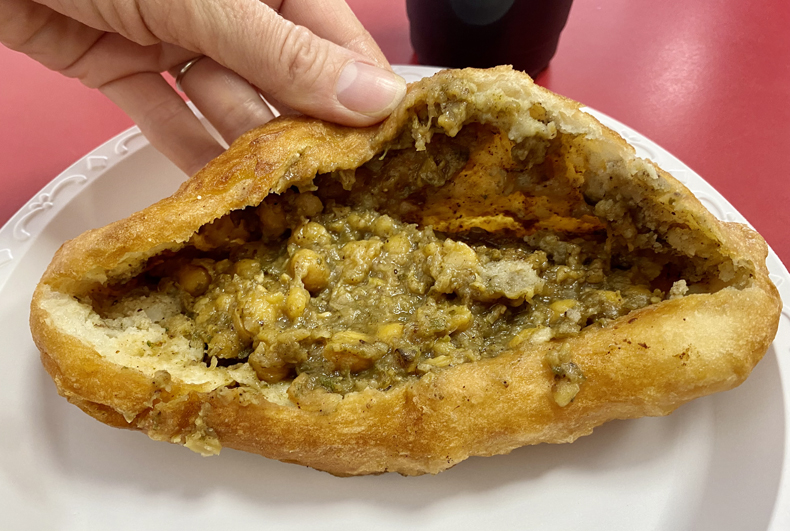
Stop 4: Aloo pie with channa at Tropical Jade 3
Continue walking east about two blocks to Tropical Jade 3 Roti Express (118-30 Liberty Ave.), the third Tropical Jade in the neighborhood (and, yes, they’re all a bit different!). This Trinidadian place is a feast for the senses—the music, the colorful lights, the seemingly never-ending steam table display of curries, noodles, and more. Don’t get too distracted! Today you’re here for one delicious snack, one of my favorites: aloo pie stuffed with channa, or chickpea curry.
Aloo pie is a simple oblong piece of fried dough with a seasoned potato (aloo) filling. (Think: knish, but breadier.) Asking for it stuffed with channa is a popular way to eat it (among both Trinidadians and Guyanese), especially earlier in the day. But it works at any time! I suggest you order it with everything, which means it comes dressed with (spicy) pepper sauce and tart tamarind.
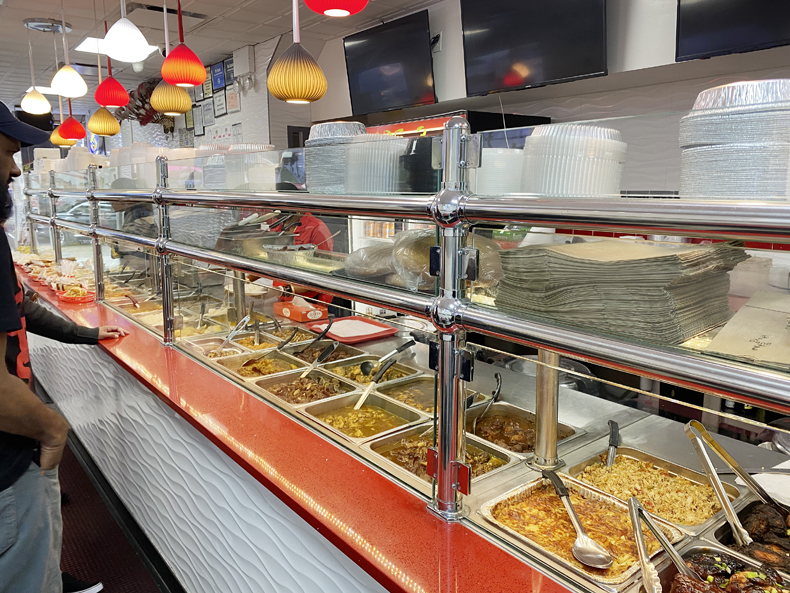
At the register, there’s usually house-made orange juice, sorrel, and mauby. If you’re ready for a sweet and tart beverage, try the delicious, refreshing sorrel here. Grab a table to dive into your snack.
Order: One channa-stuffed aloo pie with everything, one sorrel ($4.50 for both). Accepts credit cards; there is a bathroom here.

Stop 5: Pumpkin doubles at Sonny’s Roti Shop
Cross the street to Sonny’s Roti Shop (118-06 Liberty Ave.), a cute eatery with some seating along the wall up front. Broadly speaking, if a place has “roti” in the name, it will likely carry more Trinidadian dishes, which also means you’ll find doubles—and that’s why you’re here.
Doubles sandwich channa, those curried chickpeas, between two pieces of bara, squishy circles of fried dough. They’re usually topped with a number of delicious condiments: pepper sauce, tamarind sauce, pickled green mango, sometimes grated cucumber. Doubles are an incredible, inexpensive, and vegan on-the-go snack particularly popular for breakfast.
Since our last stop featured chickpeas, however, we aren’t getting straight-up regular doubles here. Sonny’s has some excellent variations (including a very good boneless chicken variety), and we’re here for the pumpkin ones. My sources tell me this is a Guyanese spin on doubles that you won’t find anywhere else.
I love this dish—it’s sweet and spicy, tart with tamarind, messy and delicious. There are still chickpeas in there; it’s just adding pumpkin to the party. Of course, you’ll want to get it with everything. If you’re feeling ambitious, also try the saheena, a spinach fritter made with split peas and served with that tasty tamarind sauce.

Check out the house-made Caribbean drinks in the refrigerator. I’m partial to the sweet and creamy sea moss, combining boiled sea moss (a type of red algae) with milk, sugar, nutmeg, and other spices. There’s also a delicious peanut punch (like a peanut butter shake), sorrel, and a very bitter mauby drink on hand.
Order: Pumpkin doubles ($2.99), plus optional saheena fritter and sea moss or peanut punch (or other beverage; $3.50-$4.95 each). Accepts credit cards.
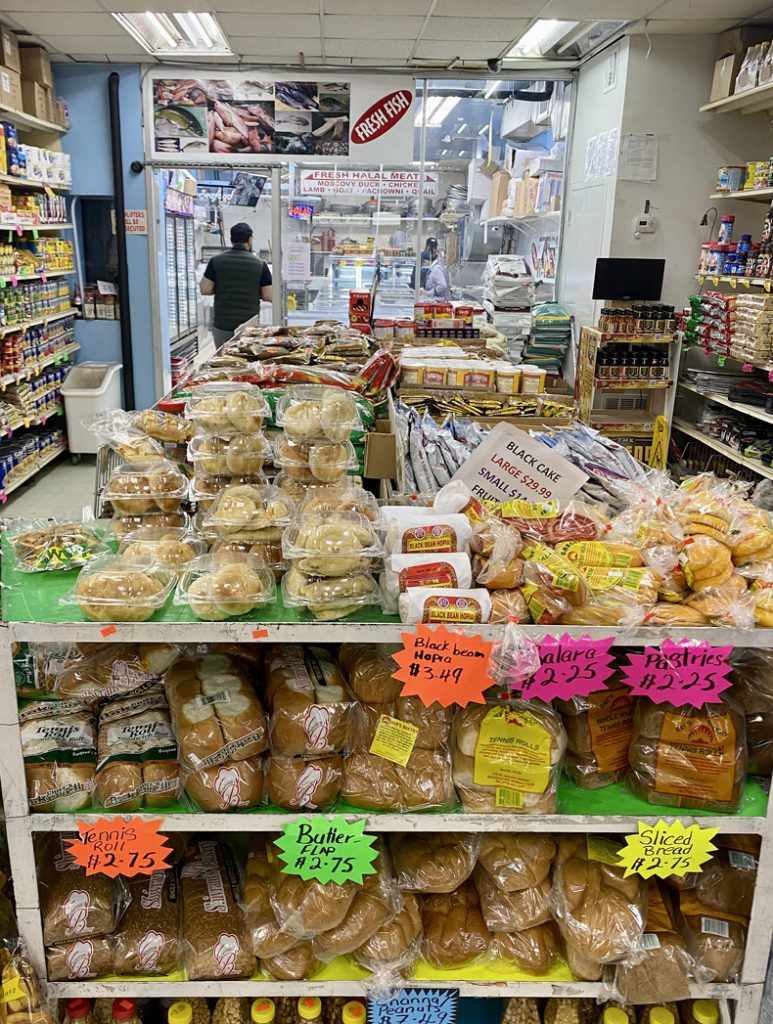
Bonus stop: Shopping break! Take a browse next door at Dave’s Fish Market + Grocery (118-08 Liberty Ave.). Pretty much everything in here is imported from Guyana or the Caribbean in general, even the fish in the back. If you have a shopping bag, you’ll want to stock up on some West Indian hot sauce (beware, even the “mild” is pretty hot to my palate); maybe some chutneys (try a spicy, mouth-puckering lime-chili mix) or achar/pickle, like sour mango; and a juice for later from the cooler (I loved the soursoup and cherry ones). If you’re inspired to cook some Guyanese food at home, you can pick up a bottle of cassareep, a thick, dark, caramelly sauce made from cassava root that’s essential to a few dishes (namely, cassareep chicken and pepperpot, Guyana’s national dish). This use of cassava in the cuisine is considered an important contribution from the country’s Native Americans.
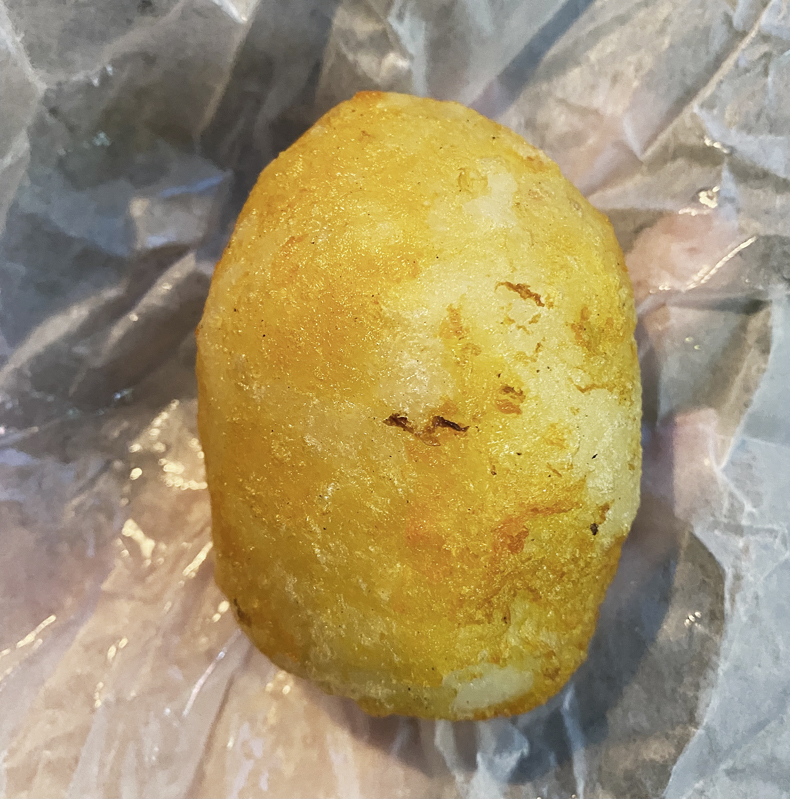
Stop 6: Guyanese egg ball at Tropical Isle Roti Shop + Bakery
Cross the street again to corner shop Tropical Isle Roti Shop + Bakery (118-19 Liberty Ave.). Inside is a mind-boggling display of baked goods, a steam table with hot foods (there’s terrific duck and goat curry here!), and a glass counter with lots of fun Guyanese snacky items, which is where our focus is now. Everything in there is worth trying, from the potato balls to the chicken patty and the sweets (cassava pone, coconut-laced salara). But I’m recommending a small snack that tells a big story of migration and conquest: the egg ball.
A Guyanese egg ball is, simply, a boiled egg encased in soft cassava that’s been seasoned and fried. (Cassava balls are the same thing, sans egg.) It instantly calls to mind the British Scotch egg, which wraps sausage and bread crumbs around an egg before deep-frying, and which itself was likely inspired by India’s nargisi kofta, a dish that pairs minced meat-wrapped boiled eggs with curry. (To further complicate matters, the Dutch also have a similar dish called vogelnestje, boiled eggs wrapped in meat and served in sauce, which may or may not be traced back to the Dutch East Indies and modern-day Indonesia’s bakso telur, or “meatball eggs”.)
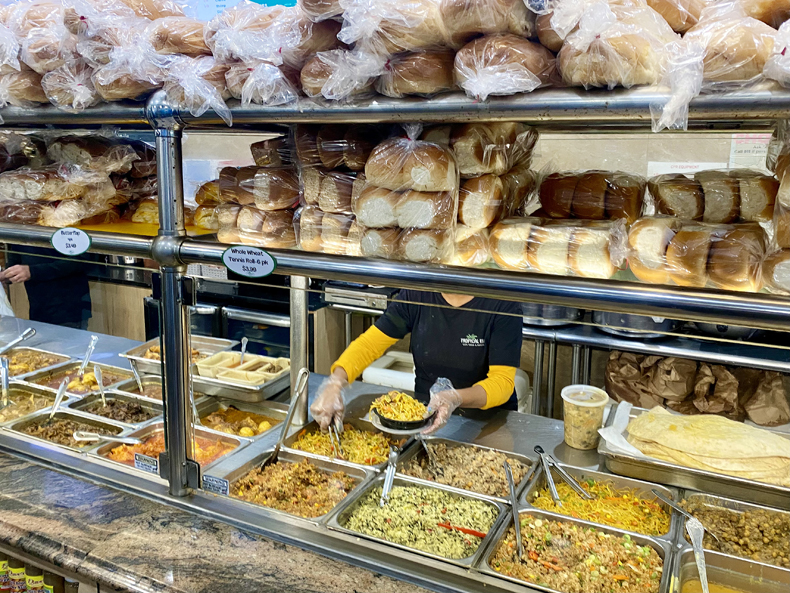
However this egg ball came to be, it’s fully at home in Richmond Hill, Queens. Be sure to get some pepper sauce or mango achar to eat it with.
Order: One egg ball ($2.99). This is also a great place to pick up soft, lemony tennis rolls—I promise you’ll enjoy eating those all week (with butter or cheese for breakfast!), or you can freeze them—but there will be another opportunity later in the tour too. Accepts credit cards.
Good to know: The intersection you’ve arrived at—Lefferts Blvd. and Liberty Ave.—was officially co-named Little Guyana Avenue in 2021, a big-deal recognition for the Guyanese community here. It’s also a good spot to catch the Q10 bus back to the E train if you’re too full to continue, or short on time. But come back another time to check out the second half of this loop guide! (And be sure to grab some curry and roti from this last stop to try later.)

Stop 7: Guyanese-Chinese food at Kaieteur Express
Cross Lefferts and look for Kaieteur Express (120-04 Liberty Ave.), the second location of a mainstay North Richmond Hill restaurant named for Guyana’s Kaieteur Falls, the world’s largest single-drop waterfall.
Like many Guyanese-Chinese eateries, the vibe here is kind of dark and clubby, with loud music and a bar in the back. The deep banquet tables can easily seat large groups, and the menu includes both West Indian and Chinese-influenced dishes. Given the sheer number of fried rice and chow mein/lo mein dishes available, I recommend focusing there.
I loved the cha chi kai chicken (spicy fried chicken) from the appetizer menu, the spicy jerk chicken fried rice, and the (sweet, jumbo) pepper shrimp lo mein (the regular shrimp chow/lo mein is great too). Pair it with a West Indian cream soda!
Order: Cha chi kai chicken ($11.99); lunch portions of fried rice/lo/chow mein dishes range $6.99-$8.99 (you must specifically order smaller lunch portion, or you’ll get larger regular portion), plus a drink of your choice. Accepts credit cards; there’s a bathroom here.
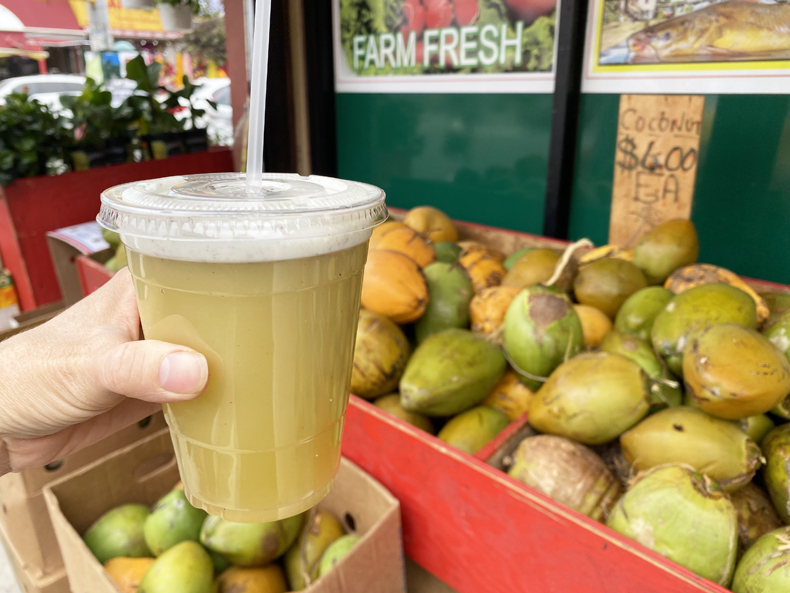
Stop 8: Sugarcane juice at J&B West India Grocery
A few blocks farther east along Liberty, J&B (124-02 Liberty Ave.) is a stop for the history buffs: Established in 1977, it was one of the first Guyanese businesses here in Queens. You’re going to visit the sugarcane juice guy along the side of the shop, but first pay for it inside. He’ll make the frothy, sweet, earthy drink right in front of you.

Afterward, it’s worth browsing the produce shops at this intersection—three of the four corners sell fruits and vegetables, many of them Indo-Caribbean-specific (and many of them very inexpensive; think nine limes for $1!). You’ll see lots of bora/bodi (long beans), karela (bitter melon), eddo (similar to taro root), katahar (breadfruit), okra, green plantains, coconuts, Indian squash, hot peppers of all sorts, and more.
Order: One sugarcane juice ($6). Accepts credit cards.

Stop 9: Roti + curry (to go) at Anil’s Roti Shop
It’s too much to eat what constitutes a (very) full meal at this point in the tour, but you’d be remiss to come to South Richmond Hill and not eat or bring home roti and curry. Anil’s Roti Shop (125-01 Liberty Ave.) is a cute Trinidadian eatery with lots of great options: curry chicken, beef, goat, duck, shrimp, and sometimes crab.

I can vouch for the rich, delicious duck curry with a side of roti, the customary soft, oversize Indo-Caribbean flatbread. Or you can try the dhal puri on the side (or get both—they keep well in the fridge if contained). Dhal puri is like roti with ground-up yellow split peas inside.
Order: Duck curry, or similar, with roti ($13). Accepts credit cards; there is a bathroom here.
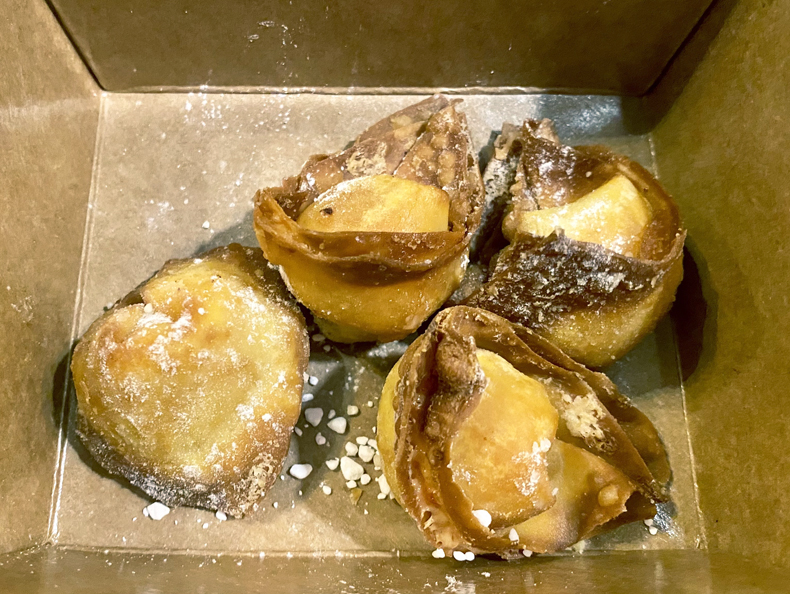
Stop 10: Sweet fried wontons at Mr. Wonton, Nest Restaurant
It’s time to walk back up to 101st Avenue, two avenues to the north. Take 125th Street, and when you reach 101st, you’ll see Nest Restaurant (125-17 101st Ave.) across the street and to your right. You’re having a quick dessert.
Nest has lots of Guyanese-Chinese dishes on the menu, but in April 2021 it launched Mr. Wonton, a line of savory and sweet fried wontons with dipping sauces. For now, skip the savory ones—everything from spicy Thai shrimp to buffalo chicken and coconut curry—and try a sweet variety. I loved both the guava with cheese and the pineapple wonton. Remember that classic Guyanese pine tart you tried at the beginning of this tour? It’s essentially that in fried wonton form.
It’s another brilliant reimagining of Guyanese flavors via a Chinese method, and it’s the perfect bite to (almost) end on: not quite Guyanese, not quite Chinese (or Indian), not quite traditional to anywhere, but perfectly at home in Richmond Hill, Queens.
Order: One pineapple or guava-cheese fried wonton, $11.95 for 8. Credit cards are accepted; there is a bathroom here.

Stop 11-12: Punjabi sweets at Punjabi Dhaba or Guyanese sweets at Guyana Choice Bakery
Are we still eating? That’s up to you, but you’ll pass by both of these eateries on your five-and-a-half-block walk back to Lefferts Avenue and the Q10 bus we started on. I’m also a fan of bringing tastes of this neighborhood home with me, so takeout is a great option!
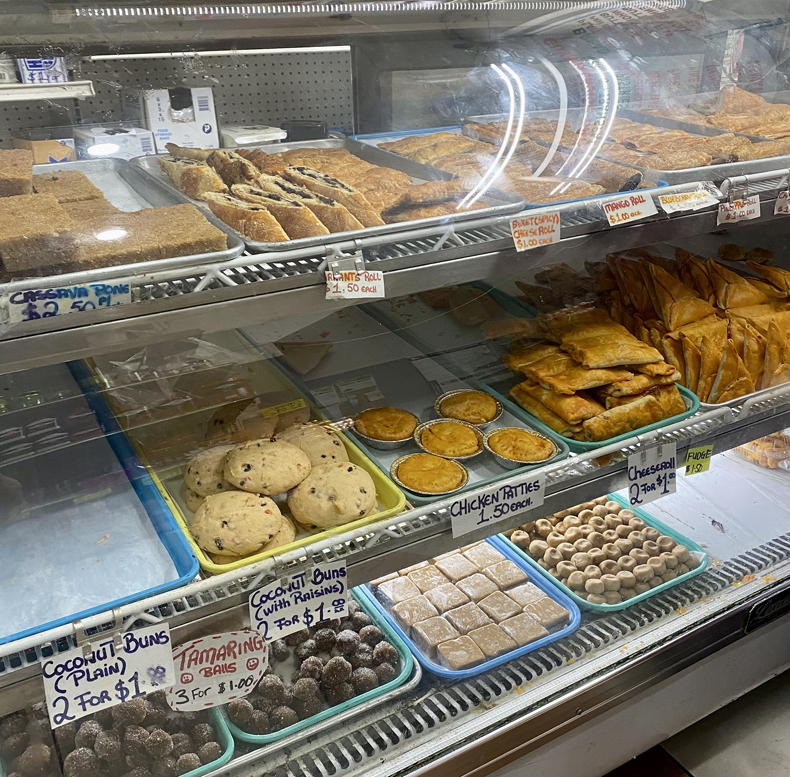
For these optional dessert stops, you can choose from a wide range of North Indian sweets—like kaju (cashew) katli, pista (pistachio) or chocolate barfi, petha (made from the ash gourd), or milk cake—at Punjabi Dhaba (119-16 101st Ave.). Or you can head next door to Guyana Choice Bakery (119-14 101st Ave.) for some traditional Guyanese and Trinidadian sweets, such as the dense cassava pone, currant rolls, tamarind balls, bread pudding, pineapple cake, or fruit rolls.
Choose your own adventure for you final sweet. Let your curiosity guide you, and be sure to return to Richmond Hill for more deliciousness soon!

